I thought of that question on the day I met Dr Syed Zamir Akhtar Naqvi, a Shia scholar and public speaker. “Anything you might want to ask me, you can read about in my books,” he said after I was introduced. “And every year, the TV waalay take my interview, so you can find those online. In fact, if you just write my first name in Google, it automatically fills in the rest.”
I met Dr Naqvi a few days before the start of Muharram, the month of mourning for the death of the Prophet Muhammad’s grandson Imam Hussein in the Battle of Karbala in 680 CE, almost 50 years after the death of the Prophet. In gatherings of Shia Muslims during this month, a horse (often snow-white) called the Zuljinnah will make an appearance, walking with the mourners during the processions. It has no rider, nor will it ever have one. The Zuljinnah (meaning "the two-winged one") is a replica of the horse Imam Hussein rode.
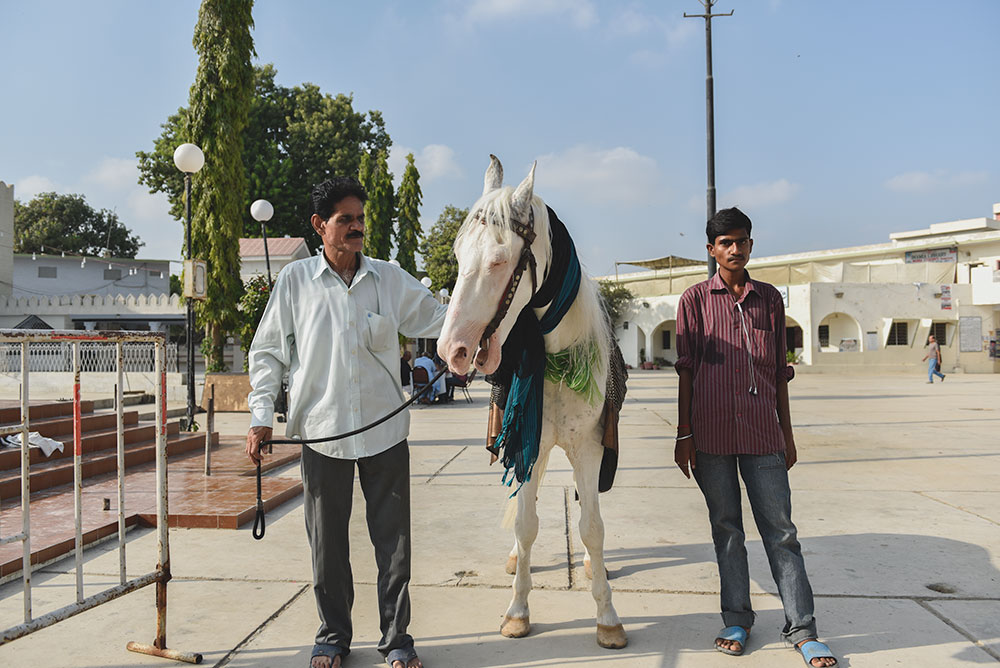
All photos: Sitwat Rizvi.
The battle of Karbala
According to accounts of the battle of Karbala, Imam Hussein and his 72 compatriots (including the Imam’s six-month-old baby boy) were brutally killed by a corrupt caliph’s army of up to 10,000 men and at the time of his death, the Prophet’s grandson had been alone, shot at by arrows and stabbed 33 times. His body was pummelled under the hooves of the caliph’s army’s horses before he was beheaded. Legend has it his loyal horse refused to abandon him. The Arab stallion wept, and, covered in his master’s blood, returned to the camp to inform the remaining women and children of Imam Hussein’s death. In the years since, this moment – when the cleft between Shia and Sunni Muslims deepened irreparably – has been resurrected in this witness every year during Muharram.
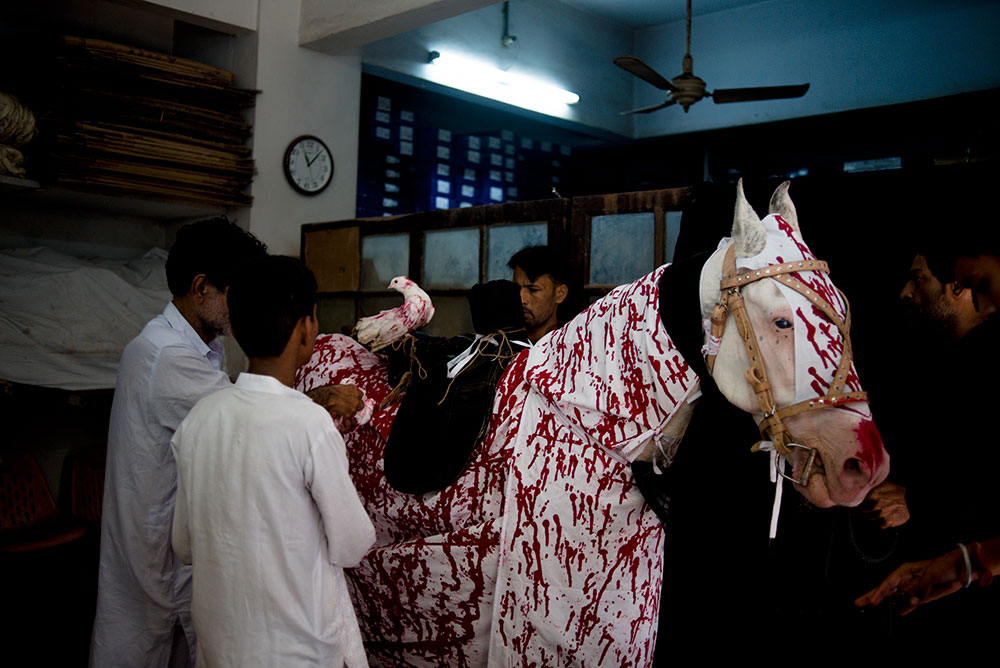
“While thousands of men killed the Prophet Muhammad’s grandson in their bloodlust, an animal remained the only true, loyal creature,” Dr Naqvi said. But there was another story, one closer to us in time, that he narrated about the Zuljinnah. “Mohammed Ali Jinnah’s daadi had prayed for a healthy son after she gave birth to 11 stillborns,” he said. “She made a mannat, prostrating herself before a Zuljinnah, and the twelfth baby she had was Quaid-e-Azam’s father. He was saved.” Dr Naqvi said the child was named Zuljinnah Poonja and the family name was thus "Zuljinnah", in honour of Imam Hussein’s horse. The name was later clipped to "Jinnah". “Toh kiss ne banaya Pakistan? … Zuljinnah se baat chali, Pakistan pe khatam hui,” (So who really made Pakistan? The story starts with the Zuljinnah and ends with the creation of Pakistan) Dr Naqvi claimed.
While this story is rubbished by many in the Shia community, it is just one of many myths about the Zuljinnah that hold sway. In Pakistan, it is not uncommon to see women whisper in the ear of the horse when it appears at processions and gatherings; if the horse nods its head, it is believed, your wish will be granted and your troubles eased. Parents pass their babies under the horse so that they may forever remain in the Zuljinnah’s saaya or protection. When I asked if he personally felt this connection with the Zuljinnah – he has even owned two such horses – Dr Naqvi tried to break down this devotion for me. “Think of Christians and their Christmas trees,” he suggested. “Or Hindus with their mandirs or the Ganges.”
But could he recall any time he felt this connection? I persisted.
Dr Naqvi paused. “Ye Sunni aur Wahabi ki samajh mein nahin aata. Aur aap unn ko samjha nahin saktay,” he said, dismissing me. Sunnis and Wahabis do not understand this. And you cannot make them understand.
The Badshahs of Karachi
Shahbaz Badshah was just a year old when he came to Karachi from his home in Lahore, 16 years ago. He lives in a room off the Rizvia Imambargah, and, until a few years ago, he shared the room with Qamar Badshah. Before Qamar died at the age of 32, there was a great deal of discussion over who would make the best companion for him in his old age. “Jab hum shaadi karnay jaatay hain toh hum larki ya larkay ko kitna dekhtay hain,” explains Noor Reza, who works at the imambargah. “Ab ye Imam ki sawari hai – sochein iss ke liye hum ne kitna dekha.” (When we decide to get married, we vet the boy or girl thoroughly. Now this is Imam Hussein’s horse – just imagine how much vetting we did for him).
Badshah is a white, suede-soft stallion. He has one milky blue eye, the persistent effect of a scratch. His doctor travels from the outskirts of the city every day to tend to the eye, and when Badshah leaves his quarters, a black chadar is draped over his body. The fabric marks him out as Imam Hussein’s horse, a Zuljinnah, and protects him from the evil eye. A taweez on a black cord is looped around his neck at all times. He wakes at Fajr and his ears and face are cleansed and his body brushed. He is taken from one bed to another, so the first can be cleaned. After a brisk walk on the imambargah’s grounds, its time for breakfast. His sweat is dried with a towel and he is served apples, grass and grains.
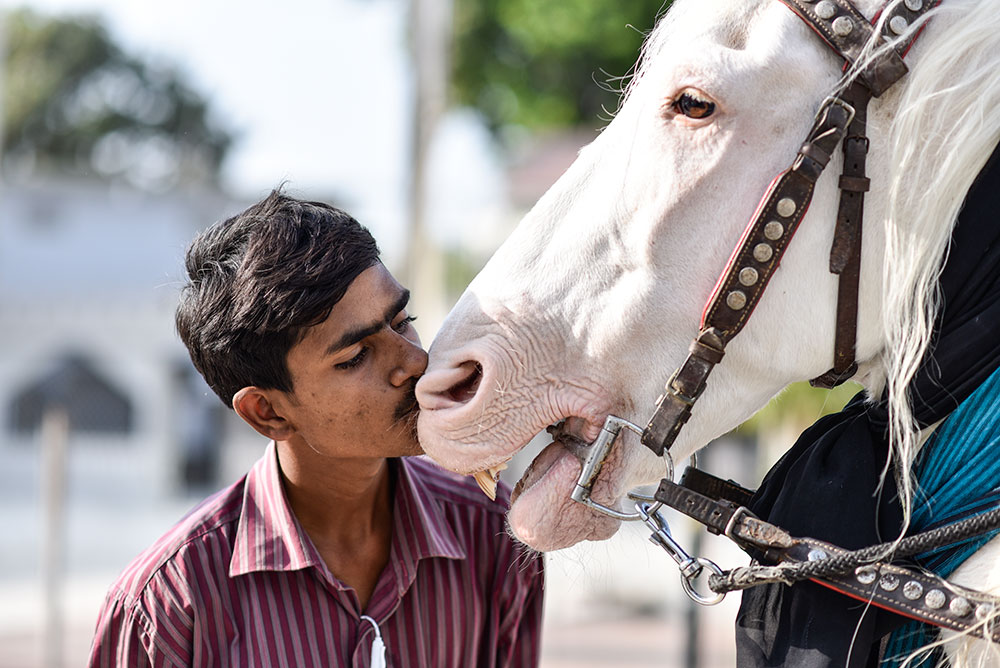
At 3 pm, Badshah is brushed once more and massaged with coconut oil, before he feeds on lunch. He roams the imambargah’s grounds until the evening and, if the electricity has not gone, he is taken back to his room. “We don’t want him to be alone in the dark,” explains 44-year-old Nadeem Zaidi, one of his caretakers (there are six). On some days, Badshah has visitors. Men and women – Shias, Sunnis, Hindus and Christians – bring him apples, milk, jalebi or mithai as offerings in thanks for a wish or prayer that has been granted. “We get people from all religions here, there are no differences when it comes to Badshah,” explains Nadeem. “Some Hindus or Christians put a dish at Badshah’s feet and run milk over his body and wash his feet in it,” he explains. “They take the milk with them, or ask us for water he has drunk from so they can give it to the elderly or unwell.”
The offerings are thoroughly checked. After a string of incidents when poisoned mithai was fed to a Zuljinnah, the caretakers have learned to be cautious. “Some say how we treat Badshah is a gunnah or un-Islamic and they want to stop it,” explains Nadeem. Their fears are not misplaced: another Zuljinnah in Karachi, Shehnshah, received death threats in the form of letters and phone calls to his caretakers. “We will shoot the horse the minute it comes on the road,” the letters warned. Shehnshah is encircled by up to 10 armed boys on motorbikes when he walks on the road. If you bring him an offering, the rule is simple: you eat it first, before it is given to the horse.
…
Treating divinity right
It is not easy to care for a Zuljinnah. As Nadeem puts it, “They live the lives of badshahs.” He cups his hands together in prayer, explaining, “We lift Badshah’s faeces like this. We believe we are his servants and this is a duty that Imam Hussein has granted us.” The horses are brought in public for two months only – before and during Muharram – but they are cared for the whole year around, and the caretakers cover for each other so they are able to hold down alternative, paying jobs. “My job is only there to make sure my children don’t go hungry,” explains 40-year-old government employee Kashif Zaidi. “But my true duty lies here with Badshah. When my son was only four days old, I left his side in the hospital to come here. My relatives were shocked, but it was time for Badshah’s meal.”
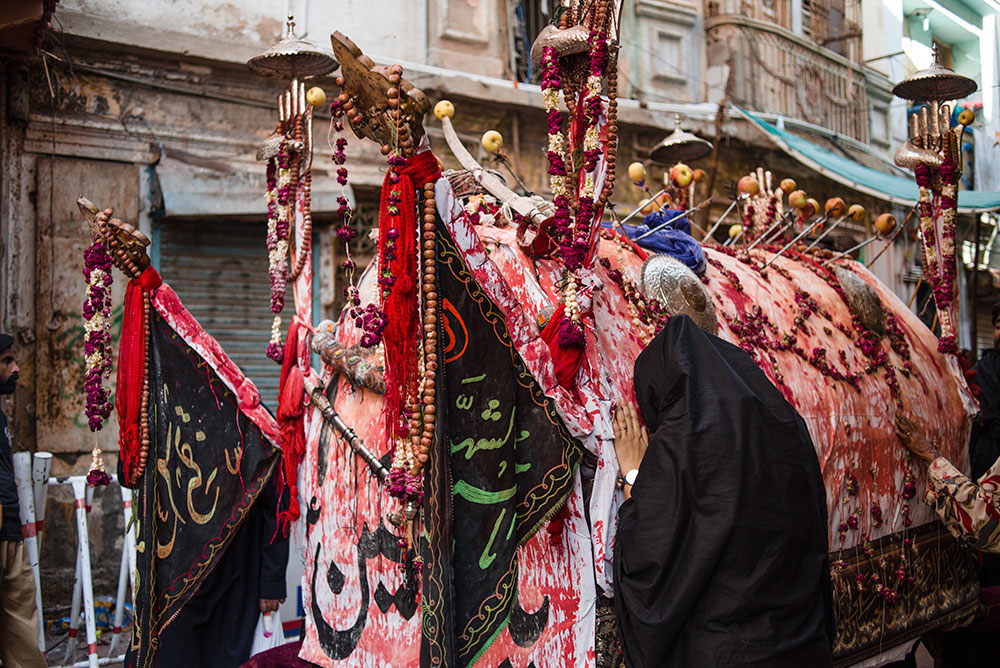
The caretakers all say they were given a nudge from the divine to do this work. “My uncle got very sick when I was a child and doctors told him he had a hole in his heart and couldn’t survive,” explains Nadeem. “His condition worsened to the point where he couldn’t speak. One day, he gestured to his brother and asked for a pencil and paper.” Nadeem’s uncle told the family he had dreamed of a Zuljinnah and prayed to get better. Family members were dispatched to the market and a horse was procured, bathed and brought to the hospital. Someone whispered in the uncle’s ear, ‘The Zuljinnah has come.’ The bed-bound weak patient reportedly leaped up and ran down two flights of stairs to walk the horse home. There, he fed the horse milk and jalebis that were slathered on his chest. “My uncle lived for 30 years after that,” Nadeem says. “I have known since then that caring for this creature is the work for me.”
Others say divine intervention arrives in other forms. Kashif has been caring for Zuljinnahs for 20 years now. He recounts one particular night when he woke from his sleep in the horse’s quarters as he sensed that someone was there, cleaning, brushing and towelling Badshah. “I could not see anything, and then a voice commanded, ‘Go back to sleep.’” When Kashif told a cleric about the vision, he was told, “Your duty to this animal lasts until 12 am. After that, another makhlooq, another being, takes over.”
This midnight hour, the caretakers say, is all the more sacred as the ninth of Muharram melds into the tenth – the day Imam Hussein was martyred. On that day, Badshah refuses to eat; his sorrow and understanding of the events of that day are too painful, the caretakers explain. On the night of the ninth, he is covered in embroidered and sequinned chadars and silver jewellery, a feathered plume, bridle and saddle. After Muharram, these accessories are buried or dropped into the ocean; new ones are made every year and the old ones cannot be used for any other purpose.
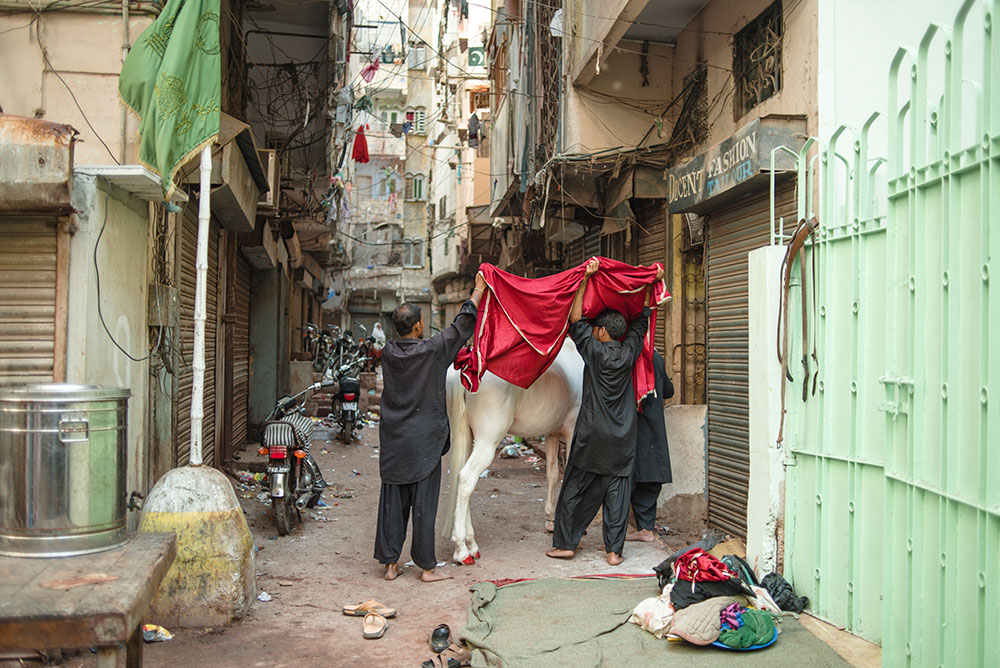
A few minutes before midnight on ninth Muharram, Badshah is given the traditional wuzu or ablutions before prayers and the azan is whispered in both his ears. The horse is told, ‘You are now Imam Hussein’s steed.’ A mirror is then placed before him, so he may witness his transformation. “At that moment, you can sense another presence,” says Kashif, his voice catching. “I have goosebumps just talking about it, but at that time, you see how the horse carries himself differently as he walks out into the juloos, surrounded by hundreds of men wailing and beating their chests. He is bearing a rider.”
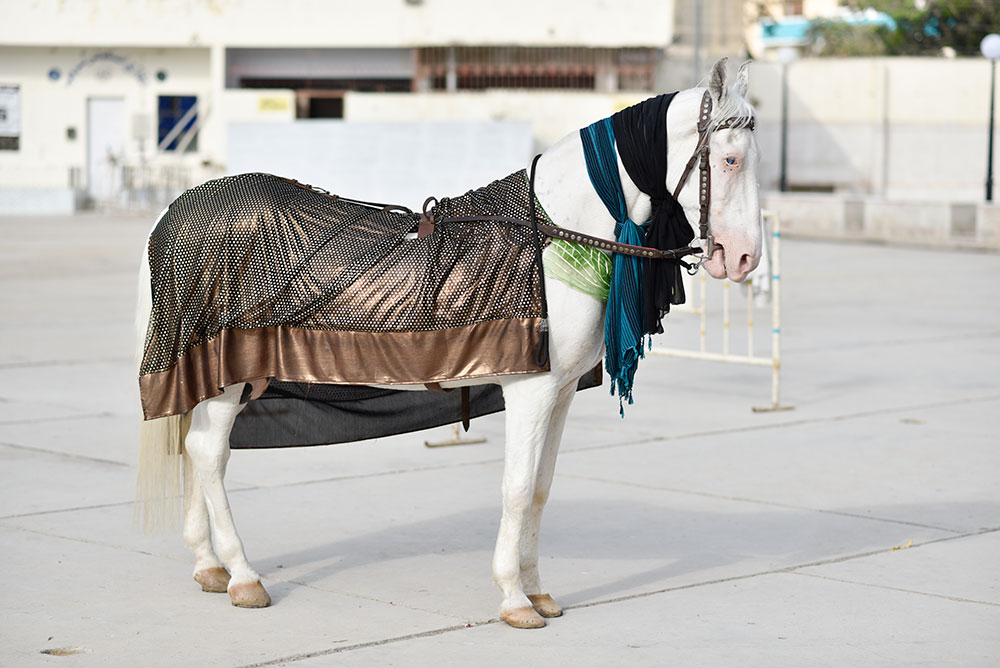
Sanam Maher is a journalist from Karachi whose Twitter handle is @SanamMKhi.










